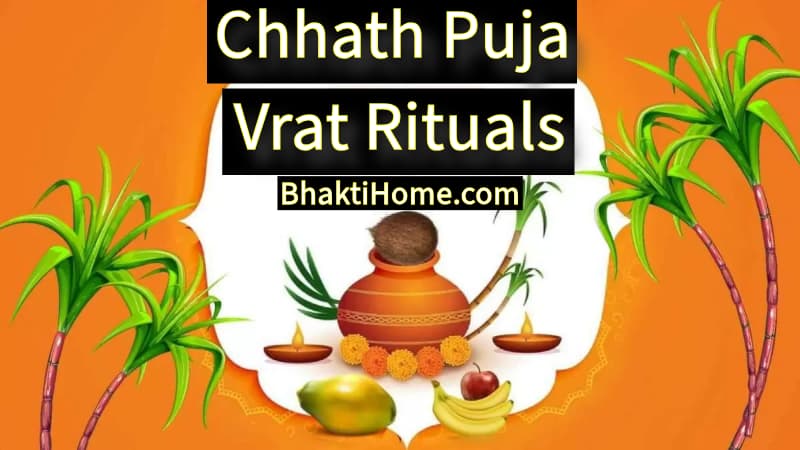
Chhath puja vrat rituals - Chhath Puja is an ancient and significant festival celebrated primarily in the Indian states of Bihar, Jharkhand, and Uttar Pradesh, as well as in various parts of Nepal.
This four-day festival honors the Sun God, Surya, and his sister, Chhathi Maiya, and is characterized by rigorous rituals and heartfelt devotion. The celebrations begin with Nahay Khay, where devotees purify themselves, and culminate with the Usha Arghya, offering prayers to the rising sun.
Chhath puja vrat rituals | Step by Step Guide
Throughout this period, followers adhere to strict fasting rules, emphasizing purity and gratitude. The story behind Chhath Puja is rooted in the epic of Ramayana, highlighting the devotion of Sita, the wife of Lord Rama, who worshipped the Sun God to seek blessings for her family.
This festival not only strengthens familial and community bonds but also promotes a deep respect for nature and its vital resources. Whether you are looking to understand the rituals, fasting rules, or the cultural significance of Chhath Puja, this guide will provide you with comprehensive insights into one of India’s most revered festivals.
Chhath Puja Vrat Rituals: Step-by-Step
Chhath Puja is celebrated over four days, each with specific rituals and traditions. Below are the detailed steps for each day:
Day 1: Nahay Khay
- Purification:
- Devotees take a holy dip in a river or water body to cleanse themselves.
- The significance of water symbolizes purity and the beginning of the rituals.
- Meal Preparation:
- A simple vegetarian meal is prepared, typically consisting of rice and lentils (dal) without any spices or salt.
- This meal is consumed by the family, symbolizing simplicity and gratitude.
- House Cleaning:
- Homes are cleaned and decorated, as cleanliness is paramount during this festival.
Day 2: Kharna
- Fasting Begins:
- Devotees observe a day-long fast, refraining from food and water from sunrise until sunset.
- Meal Preparation:
- In the evening, a special meal is prepared that includes kheer (rice pudding), puris, and seasonal fruits.
- Breaking the Fast:
- After sunset, the meal is offered to the Sun God along with prayers, and then shared among family members.
- Worship Rituals:
- Devotees light a diya (lamp) and offer prayers, thanking the Sun for their sustenance.
Day 3: Sankat
- The Main Day of Worship:
- Devotees begin a 36-hour fast, consuming no food or water. This is the most rigorous day of the festival.
- Offerings Preparation:
- Thekua (a sweet made of wheat flour, jaggery, and ghee) and fruits are prepared as offerings.
- Evening Worship:
- Devotees gather at the riverbank during sunset to offer arghya (offerings) to the setting sun.
- They pray for health, prosperity, and the well-being of their family.
- Family Gatherings:
- This day often includes family and community gatherings, strengthening social bonds.
Day 4: Usha Arghya
- Morning Rituals:
- Devotees wake up before dawn to reach the riverbank for the morning worship.
- They prepare offerings and set up the puja area with utmost care.
- Offering to the Rising Sun:
- During sunrise, arghya is offered to the Sun God, with prayers for blessings and prosperity.
- Breaking the Fast:
- After the rituals, devotees finally break their fast, typically with a celebratory meal, sharing the prepared offerings with family and friends.
- Conclusion of the Festival:
- The festival concludes with gratitude and a celebration of nature and the Sun's energy.
Chhath Puja Fasting Rules
- Purity:
- Devotees must maintain physical and spiritual cleanliness throughout the festival. This includes wearing clean clothes and using purified vessels for cooking and offerings.
- Diet:
- Only vegetarian food is allowed, and salt is avoided, particularly during the fasting days. The meals prepared should be simple and pure.
- Fasting Norms:
- Fasting is strictly observed. On Kharna, the fast is broken after sunset with specific offerings. On Sankat, the fast is more stringent, with no food or water consumed.
- Focus and Devotion:
- Devotees are encouraged to focus on their prayers and maintain a devotional attitude, refraining from any distractions during the fasting period.
Chhath Puja Story
The origin of Chhath Puja is deeply rooted in Hindu mythology, particularly associated with the epic of Ramayana. Here’s a detailed account of its significance:
- Historical Context:
- Chhath Puja honors the Sun God, Surya, and is believed to have been first performed by Sita, the wife of Lord Rama, after her return from exile. It is said that she prayed to the Sun God for strength and health for her family.
- Sita's Worship:
- According to legend, after the birth of her sons, Lava and Kusha, Sita performed this ritual to thank the Sun God for his blessings and to seek protection for her children.
- Symbol of Nature:
- The festival emphasizes the importance of nature and the sustenance provided by the Sun. It encourages respect and gratitude towards the environment.
- Cultural Significance:
- Over generations, Chhath Puja has transformed into a community festival, where families come together to celebrate and participate in the rituals, reinforcing social and familial bonds.
- Modern Celebrations:
- Today, Chhath Puja is celebrated not just in India, but also by the Indian diaspora around the world. The festival continues to embody themes of devotion, community, and respect for nature.
This rich tapestry of rituals, rules, and historical significance makes Chhath Puja one of the most revered festivals in the Hindu calendar, dedicated to honoring the natural world and its divine energies.

